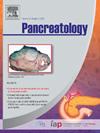胰腺导管腺癌液体活检中KRAS突变检测的临床预测因素。
IF 2.7
2区 医学
Q2 GASTROENTEROLOGY & HEPATOLOGY
引用次数: 0
摘要
背景:液体活检提供了一种替代组织标本进行全面的基因组分析。然而,循环肿瘤DNA (ctDNA)的检测在胰腺导管腺癌(PDAC)中仍然具有挑战性。本研究评估了CA19-9和其他因素在液体活检中检测KRAS突变的预测能力。方法:我们回顾性分析了2021年9月至2024年8月期间接受液体活检的PDAC患者的临床和基因组数据库。结果:共纳入106例患者。KRAS突变的总检出率为48%。单因素分析发现,肝转移(优势比(OR) 4.50, p < 0.01)和CA19-9水平≥2000 U/mL (OR 3.82, p < 0.01)与KRAS突变的高检出率显著相关。这些因素在多因素分析中仍然是独立的预测因子:肝转移(OR 4.51, p < 0.01)和CA19-9≥2000 U/mL (OR 3.91, p < 0.01)。同时存在这两种因素的患者中有79%检测到KRAS突变。在102例患者的总生存期(OS)分析中,检测到KRAS突变与较差的预后相关(检测到vs未检测到:16.5 vs 26.9个月,p = 0.02)。根据最大变异等位基因频率(Max VAF)对KRAS突变患者进行进一步分层,结果显示,与最大VAF患者相比,最大VAF患者的OS明显缩短了10%。结论:CA19-9水平和肝转移可预测ctDNA中KRAS突变检测。较高的Max VAF可能反映PDAC中更具侵袭性的疾病生物学。本文章由计算机程序翻译,如有差异,请以英文原文为准。
Clinical predictors of KRAS mutation detection in liquid biopsies for pancreatic ductal adenocarcinoma
Background
Liquid biopsy offers an alternative to tissue specimens for comprehensive genomic profiling. However, detection of circulating tumor DNA (ctDNA) remains challenging in pancreatic ductal adenocarcinoma (PDAC). This study assessed predictive ability of CA19-9 and other factors for detecting KRAS mutations on liquid biopsy. Methods: We retrospectively reviewed clinical and genomic databases for PDAC patients who underwent liquid biopsy between September 2021 and August 2024. Results: A total of 106 patients were enrolled. The overall detection rate of KRAS mutations was 48 %. Univariate analysis identified hepatic metastases (Odds ratio (OR) 4.50, p < 0.01) and CA19-9 levels ≥2000 U/mL (OR 3.82, p < 0.01) as significantly associated with higher detection of KRAS mutations. These factors remained independent predictors in multivariate analysis: hepatic metastases (OR 4.51, p < 0.01) and CA19-9 ≥ 2000 U/mL (OR 3.91, p < 0.01). KRAS mutations were detected in 79 % of patients with both factors. In an overall survival (OS) analysis of 102 patients, detection of KRAS mutations was associated with worse prognosis (detected vs not-detected: 16.5 vs. 26.9 months, p = 0.02). Further stratification by maximum variant allele frequency (Max VAF) among patients with KRAS mutations revealed significantly shorter OS in patients with Max VAF >10 % compared to those with Max VAF <1 % (10.6 vs. 19.8 months, p < 0.01) or 1–10 % (10.6 vs. 18.0 months, p = 0.02). Conclusions: CA19-9 levels and hepatic metastases are predictive of KRAS mutation detection in ctDNA. Higher Max VAF may reflect more aggressive disease biology in PDAC.
求助全文
通过发布文献求助,成功后即可免费获取论文全文。
去求助
来源期刊

Pancreatology
医学-胃肠肝病学
CiteScore
7.20
自引率
5.60%
发文量
194
审稿时长
44 days
期刊介绍:
Pancreatology is the official journal of the International Association of Pancreatology (IAP), the European Pancreatic Club (EPC) and several national societies and study groups around the world. Dedicated to the understanding and treatment of exocrine as well as endocrine pancreatic disease, this multidisciplinary periodical publishes original basic, translational and clinical pancreatic research from a range of fields including gastroenterology, oncology, surgery, pharmacology, cellular and molecular biology as well as endocrinology, immunology and epidemiology. Readers can expect to gain new insights into pancreatic physiology and into the pathogenesis, diagnosis, therapeutic approaches and prognosis of pancreatic diseases. The journal features original articles, case reports, consensus guidelines and topical, cutting edge reviews, thus representing a source of valuable, novel information for clinical and basic researchers alike.
 求助内容:
求助内容: 应助结果提醒方式:
应助结果提醒方式:


